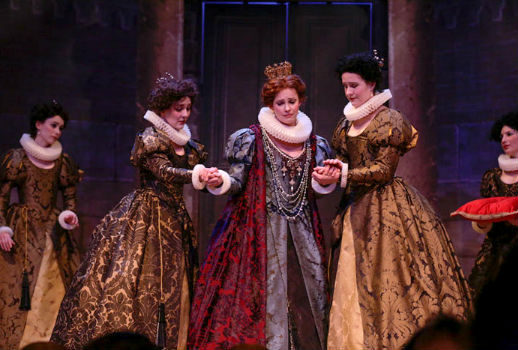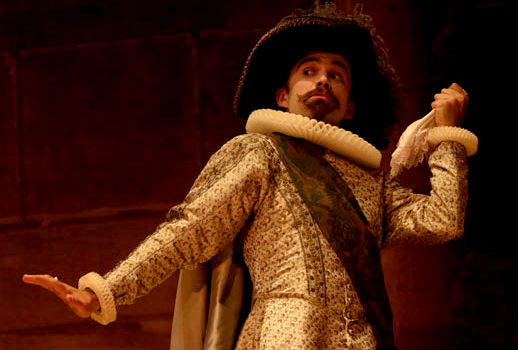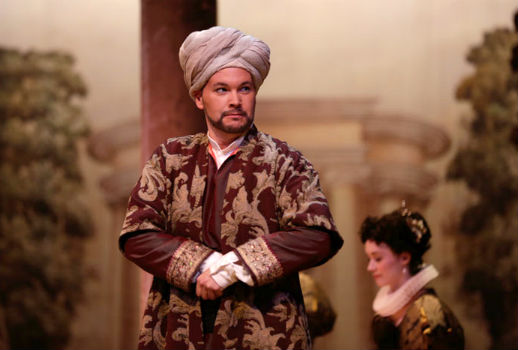
A lavish, period-style production at the Boston Early Music Festival did a good job camouflaging Friedrich Christian Feustking’s feeble libretto, set in Castile in the year who-knows-what. Upon coming of age, Queen Almira learns that her late father’s will requires her to marry one of the counselor Consalvo’s sons. The only one hanging around is the flighty Osman and he’s game but she’s not because she loves a mysterious foreigner called Fernando, who gets entangled with the princess Edilia, recently thrown over by the previously mentioned Osman, who is loved by the court lady Bellante.
After four hours of intrigue, including the appearance of a disguised king from Mauretania, the obligatory baroque prison scene, and the endless nattering of the servant Tabarco, the whole thing comes to a Gilbert and Sullivan close when Fernando is revealed as the long-lost son of the counselor Consalvo, rescued by a fisherman and identified by an engraved jewel pendant.
There’s no plot that a few gorgeous sarabandes and some manly sword-dances can’t fix, though, and superb choreography by Caroline Copeland and Carlos Fittante (and their own alert characterizations) went beyond dance suites and an entire Pageant of the Continents to include inventive pantomime and other movement from dancers, choristers, and extras that enlivened every scene.

And the swords! And the daggers! Historical accuracy is strictly enforced at BEMF (the director’s notes are full of aesthetic theory and such, wigs and makeup are fiercely researched, and faux candles light a specially-constructed communal music stand for the players), so even the use of weapons was presumably authentic.
Even though certain melodic motives, instrumental textures, and lyrical bass-line shapes sound familiar, Almira is worlds away from the London operas that brought Handel fame and then ridicule. There are no castrato roles and no cross-dressing. Arias alternate German and Italian randomly and are often short.
Recitatives, in German, have elaborate melodic shapes, even with flourishes and roulades, and they outline weird harmonies. There is plenty of ballet music, including two sarabandes that enjoyed afterlives as “Pena tiranna” from Amadigi di Gaula and Rinaldo’s “Lascia ch’io pianga,” by way of “Lascia la spina” from Il Trionfo del Tempo. By the way, if ballet mistress Melinda Sullivan’s troupe is correct, a danced sarabande is not a dirge.
Among the cast, the men won out, both in singing and in using the stylized baroque gestures and movements to convey expression and character. The excellent German baritone Christian Immler played Consalvo as a fawning but charming court politico, with extended codpiece poking through puffy striped shorts, and his opening aria, “Almira regiere,” sounded especially smooth and majestic. As the disguised King of Mauretania, Raymondo, Tyler Duncan made the most of a turban, fake beard, expressive face, and handsome, ringing voice, which he brought down to a whisper for the cadenza to “Edilia, du bleibest mein.”

Because of complications with U.S. visa service, the wonderful Argentine soprano Veronica Cangemi was denied entry, leaving Ulrike Hofbauer to take on the title role with short notice. Hofbauer’s singing was expressive and polished, especially in “Geloso tormento” and other slow pieces, but she was often underpowered and lacked the brilliance required of the virtuosic “Kochet ihr Adern.”
As Edilia, soprano Amanda Forsythe also delivered coloratura dutifully but without incisiveness or energy. In this potentially break-out role, Forsythe’s monochromatic sound and rudimentary acting fell short. Another soprano, Valerie Vinzant, was Bellante, with an eye-patch inexplicably referencing that other Spanish principessa, Eboli.
The period instrument players faced each other in two rows, with continuo groups at each end. Theorbos and guitars (played by musical directors Stephen Stubbs and Paul O’Dette), harpsichords, and baroque harp were used for a variety of textures, and the bassoon often took the bass line of soft arias. Tempos could have been more extreme, there were a few dull stretches, and one particularly lovely aria was accompanied by the unpleasantly twangy combination of harp and guitar, but these are small gripes about a beautiful, inventive, and pleasurable production.
Photos: Kathy Wittman.





Comments